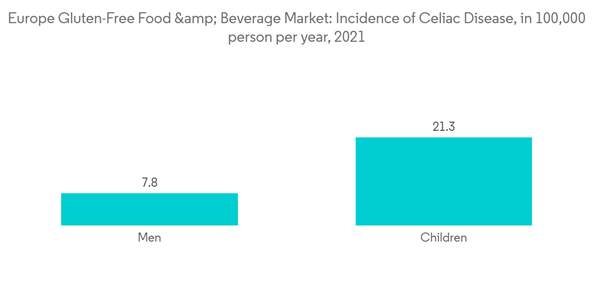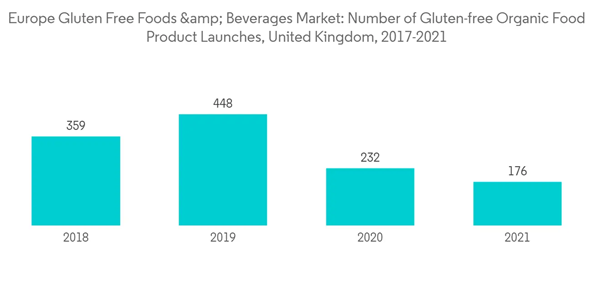Key Highlights
- The growing demand for gluten-free bakery products has been witnessing substantial growth in demand in the past few years. Germany's gluten-free bakery products segment is witnessing an increase in product launches, including gluten-free bagels, muffins, cookies and wafers, pretzels, and croissants. Germany is one of the leading markets in the region, followed by the United Kingdom and Italy.
- However, gluten-free flours used to formulate products, such as bread, pasta, and pizza, are usually highly refined flour with less fiber and a high glycemic index (GI). To match the desired taste and texture, manufacturers add fats, sugar, and other ingredients, reducing the product's healthy appeal. This factor, along with relatively high-cost conventional products, is restraining the growth of the gluten-free food market.
- General Mills Inc., one of the top key players in the gluten-free food and beverage industry, witnessed an organic growth sales of 3% in 2021. According to the Government of Canada three packaged food categories for health and wellness did better: "free from" (such as "free from gluten" or "free from meat"), "naturally healthy," and "organic."
- Additionally, the rise in popularity of the alternative meat products/meat substitutes segment has been propelling the growth of the gluten-free food and beverage products market across Europe. For instance, in 2021, a global survey by Green Queen on changing consumers pattern towards vegan diets involving 8500 participants across 100 countries including European countries like the United Kingdom, Germany, and others reported that nearly 90% of respondents cited animal welfare as a primary reason for the inclination towards a plant-based diet.
Europe Gluten-Free Food and Beverages Market Trends
Increasing Prevalence of Celiac Disease
- There is a rising prevalence of celiac disease in Europe. Celiac disease can often cause Type 1 diabetes, damage the intestine lining, and cause thyroid in some patients. Hence, consumers have been cautious regarding gluten consumption. They prefer gluten-free products to avoid such symptoms and diseases.
- According to data published by Epidemiology, Presentation, and Diagnosis of Celiac Disease, in 2021, celiac disease is now acknowledged to exist globally, contrary to earlier beliefs that it solely (or primarily) affects people in Northern and Western Europe. A comprehensive analysis of the prevalence of celiac disease worldwide indicated a seroprevalence rate of 1.4%, with regional variations in prevalence ranging from 1.3% (South America, 11 studies) to 1.8%.
- The incidence and prevalence of celiac disease are rising over time, an observation that holds across geographical locations. A systematic review and meta-analysis of 33 studies examining the incidence of celiac illnesses found that 24 (73%) showed substantial increases in diagnostic rates over time.
- Therefore, consumers are tremendously elevating toward the gluten-free diet, as gluten-free foods and beverages can reduce the effect of celiac disease by promoting intestinal healing. Thus, such factors are driving the growth of the gluten-free foods and beverages market.
United Kingdom Dominates Market in Europe
- The United Kingdom has been witnessing strong traction around free-form foods, i.e., foods made without specific ingredients, like gluten, dairy, or nuts, making them suitable for those who suffer allergies, intolerances, or other health requirements that require them to avoid certain food components.
- Gluten-free, lactose-free, soy-free, dairy-free, or meat-free are a few of the free form-food categories in the country. In line with the growing demand, retailers, such as Tesco, have made separate aisles dedicated to free-form products, including gluten-free, which has increased the consumer focus and awareness regarding the availability of such products.
- Britons increasingly avoid certain ingredients, including wheat, from their diet due to their health profile rather than medical reasons. This allows gluten-free food manufacturers to target the overall health-conscious population instead of only those suffering from celiac disease.
- According to the Leisure F&B EXPO, in 2021, in the United Kingdom, the 20-39 years old population are the primaryn consumers of a gluten-free diet, and most of these are self-diagnosed individuals, and 41% of the country's world-class athletes have said that they followed a gluten-free diet. This has increased the popularity and acceptance of gluten-free diets in recent years.
Europe Gluten-Free Food and Beverages Industry Overview
The gluten-free food and beverages market is highly competitive due to the presence of large international players and small local players. Key players include Kraft Heinz Company, Amy's Kitchen, Bob's Red Mill, Conagra Brands Inc., and Dr. Schar. The most common strategy adopted by these players is product innovation to meet consumer demand. Some of the other players in the industry also prefer mergers and acquisitions to acquire the top position in the industry and maintain dominance over other players in terms of business expansion.Additional Benefits:
- The market estimate (ME) sheet in Excel format
- 3 months of analyst support
This product will be delivered within 2 business days.
Table of Contents
Companies Mentioned (Partial List)
A selection of companies mentioned in this report includes, but is not limited to:
- Amy's Kitchen, Inc.
- Bob's Red Mill Natural Foods.
- Conagra Brands Inc.
- Dr. Schär AG / SPA
- General Mills Inc.
- Genius Foods
- Golden West Specialty Foods
- Kraft Heinz Company
- Dawn Foods
- London Food Corporation










